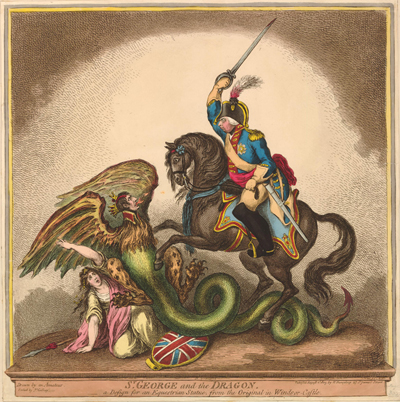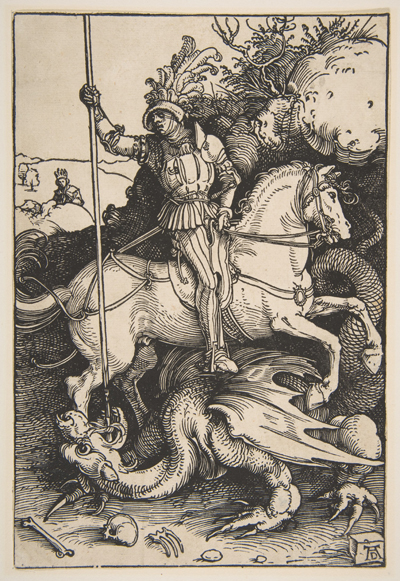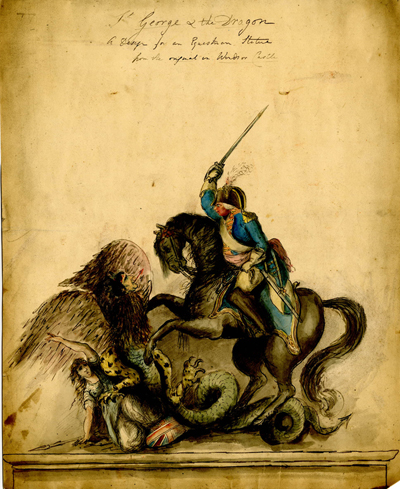St. George and the Dragon
This print is based on a drawing by Thomas Braddyll who, in 1805, was a Captain of the 2nd Foot Guards, Gillray had etched designs by Braddyll as early as 1800 with A Military Sketch of a Gilt Stick, or Poker Emblazoned (June 11, 1800). More recently Braddyll had supplied the designs for Gillray's two plates based on Gullivers Travels: both titled The King of Brobdingnag and Gulliver (June 26, 1803 and February 10, 1804).
The concept and subtitle of this print, "A Design for an Equestrian Statue from the Original in Windsor Castle," though provided by Braddyll, may have been influenced by another Gillray print, Hint to Modern Sculptors, as an Ornament to a Future Square (1796) which portrays the Prince of Wales on horseback as an (ironic) model for an equestrian statue. In this case, the heavy satire (pun intended) of the 1796 print is replaced by a lighter, sly ambiguity involving the double meaning of "Original." The print pretends to follow an original design in Windsor Castle but what it says is that it is based on the "Original" i.e. an eccentric, who inhabits Windsor Castle.

© Trustees of the British Museum
As the patron saint of England, St. George was a popular subject. Gillray himself had already used him for the 1782 print also named St. George and the Dragon depicting Sir George Rodney defeating a French Dragon. The earliest western version of the story of St. George, derives from the The Golden Legend a compilation of stories of the saints by Jacobus de Varagine. In that version, St. George saves a Princess who was being offered as a sacrifice to a dragon, wounding the beast with his lance and later chopping off his head with a sword. In prints and paintings based on the story, George is most often mounted on a rearing stallion and the princess (when she appears at all) is almost always at a safe distance from the action, usually praying for a successful outcome.

St. George and the Dragon
[ca. 1504]
© Metropolitan Museum of Art
In the Braddyll drawing, as in the Gillray print, the Princess is Britannia, the dragon is Buonaparte, and St George is, of course, King George. But far from being positioned at a safe distance, Britannia is very much implicated in this battle. She seems, in fact, to have been knocked over in the heat of the fight, dropping her spear and shield as Buonaparte falls back. And to make matters worse, as George and his stallion push forward, Britannia in real danger (as her outstretched arm and expression show) of being crushed.

Drawing - St. George and the Dragon
[1805]
© Trustees of the British Museum
In an essay entitled "Unstable Loyalism in James Gillray's The King of Brobdingnag and Gulliver, James Baker has suggested that the Braddyll/Gillray Gulliver prints are more problematic than at first they seem. The same can be said of St. George and the Dragon. What appears, at first as a simple patriotic rescue scene may, in fact, suggest that Britain's prolonged war against France endangers the health and survival of Britain itself.
As usual when he works from an amateur's sketch, Gillray stays close to the orginal in overall design. He simply makes it better—clearer, crisper, more polished. The head of Napoleon is now much more visible, his wings fully articulated. Britannia's shield has been made both more visible and more central and now clearly beneath the serpentine body of Buonaparte.
Sources and Reading
- Commentary from the British Museum on St. George and the Dragon.
- Draper Hill, The Satirical Etchings of James Gillray, 1976, #85.
- Baker, James, "Locating Gulliver: Unstable Loyalism in James Gillray's...," Image [&] Narrative, 2013
- "Saint George and the Dragon," Wikipedia
- "Thomas Braddyll," The History of Parliament
- "War of the Third Coalition," Wikipedia
- Thomas Wright and Joseph Grego, The Works of James Gillray, the Caricaturist; With the History of His Life and Times, p. 322.
Comments & Corrections
NOTE: Comments and/or corrections are always appreciated. To make that easier, I have included a form below that you can use. I promise never to share any of the info provided without your express permission.